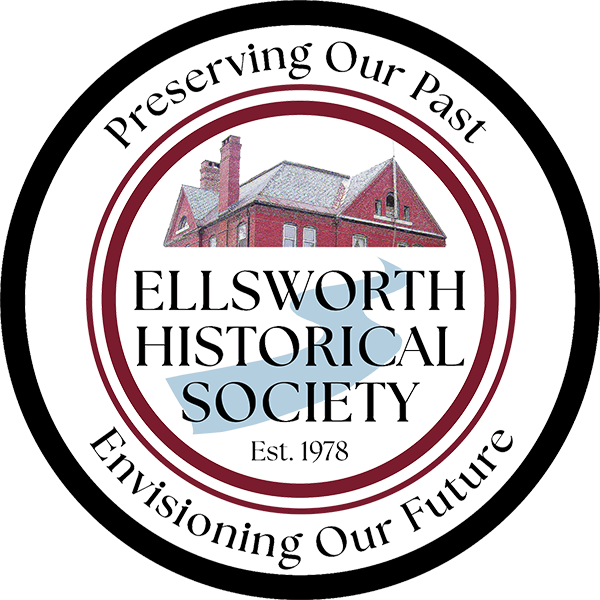Plaque 6: The Flood of 1923
The ‘freshet” of April, 1923caused serious and costly damage to downtown Ellsworth. Water levels rose dramatically in the lakes created by the 1907 dam, due to snow melt and torrential rain.
Upriver Brimmer’s Bridge dam broke through, as did a sawmill’s wing dam, sending timber and fast-moving water downstream.
The rising water carried off buildings near the river, including the Farmer’s Union Storehouse that lifted the steel bridge off it’s foundation.
Up to a quarter million board feet of saw logs and thousands ofcords of pulp and stave wood were propelled downstream, as well as a huge boat shed housing three yachts, a sloop and a tugboat.
Plaque 7: The First County Courthouse and Registry of Deeds
In 1834 work began on the new town house at the top of Bridge Hill. When Ellsworth became the shire town of Hancock County in 1837, the town house was given to the County for a Court House. The County built the red brick annex and moved the records from Castine in 1837. The County jail was built a short distance away on Pleasant Street. From then until 1885, the county held its sessions there. At that time, a new courthouse was to be built and the City of Ellsworth purchased the buildings for $1,750.00 from the County. The interior was renovated and the buildings were used as a high school until 1924.
When the Civil War began, the front grounds were used to train soldiers. In their memory, funds were raised by the citizens of Ellsworth and a monument was erected in 1887. The monument was built of Blue Hill granite and raised and sculpted by Dunn and Howard. The inscription reads “In honor of the men of Ellsworth who served and to the memory of all who fell on land and sea in the war of the Union their grateful townsmen have raised this memorial.” The monument was dedicated on July 4, 1887.
Plaque 8: Woodlawn
For 100 years, three generations of the Colonel John Black family owned and lived at the estate they called Woodlawn.
Perched on a hill overlooking the Union River and the City, Woodlawn’s unique design stands as a symbol of the wealth and status of John Black and his family.
Woodlawn, built between 1824 and 1827 is from an Asher Benjamin design entitled “A plan for a house intended for a country setting.” The design is unique in eastern Maine. It is a large, brick residence in the federal-style, with Greek Revival overtones.
The Black family wealth came from lumber, land sales and shipping.
In 1928 George Nixon Black, Jr., grandson of John Black, bequeathed the estate to the Hancock County Trustees of Public Reservations, the same group that is responsible for the establishment of Acadia National Park.
Woodlawn opened as a historic house and public park in 1929 and has since been continually open to the community as a public park year-round from dawn to dusk, free of charge.
Woodlawn retains original furnishings from the Black Family. The Best Bed dates from 1827 and is recognized as a national treasure.
Plaque 9: Ellsworth’s Lumber and Shipping Industry
· The Union River was extremely active as a shipping port in the mid-1800’s.
· Ellsworth exported barrel staves, shingles and lumber.
· In the mid 1800’s Ellsworth was considered the second largest lumber exporting port in the world.
· It was reported in 1852 that over 60 vessels were lying at the wharves on the Union River at one time.
· On one day, May 25, 1852, 24 loaded vessels left the port of Ellsworth.
· In 1851 a Customs House was built near the river to regulate shipping, collect fees and register vessels.
· In 1871 a steam tug named “Little Round Top” began 43 years of service assisting vessels down the river to the bay.
· In 1886, Ellsworth had 75 active sea captains.
Plaque 10: Shipbuilding in Ellsworth
- Transportation was a critical component of successful lumbering. Sailing vessels needed to be well built and, at the same time, built as cheaply as possible. This could only happen when a shipyard was established in a region with a ready supply of timber suitable for shipbuilding.
- Successful establishment of a lumbering industry would go hand in hand with the establishment of shipyards along the waterfront and the construction of stout vessels to carry the product to market.
- The most common ship built in Ellsworth was the two-masted schooner
- It was comparatively easy to handle rivers, harbors, and other tight waterways where market communities were located. (Honey)
- The first vessel built here was in 1773 by Benjamin Milliken and others and was named the Susan and Abigail for the eldest daughters of Benjamin Joy and Benjamin Milliken.
- By 1884, ninety-two vessels hailed from this port.
- April 1895 Ellsworth American: Captain Perry Woodward was the father in law of William Henry Titus Editor of the American.

